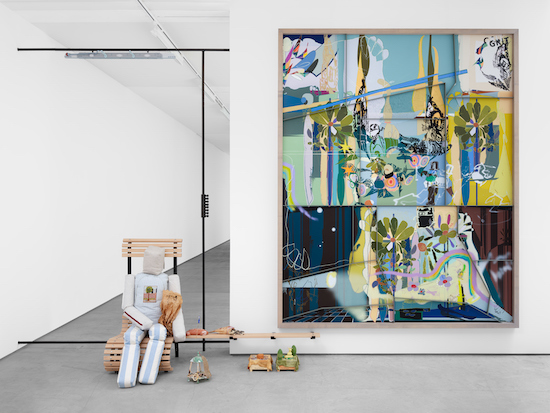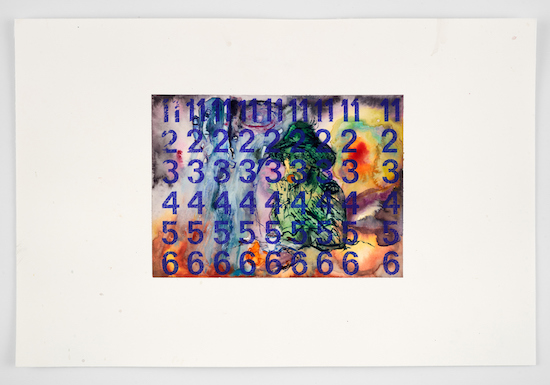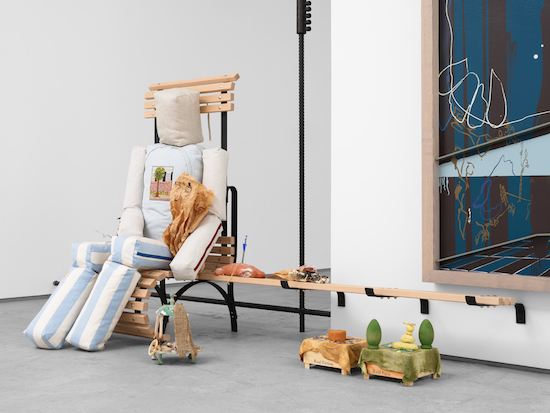Install view, Helen Marten, Sparrows On the Stone, Sadie Coles HQ, London, 4 September – 30 October 2021. photographer: Eva Herzog
Sparrows On the Stone by Helen Marten is an exhibition comprising painting, sculpture, text and installation. A multi-faceted world born out of a story by the artist that takes the shape of a person. Mapped out as the shape of a stick figure is a maze of works through which you must navigate either aided by texts that accompany each work or at your own pace.
Predating the pandemic, Marten’s use of the body for the structure of this exhibition means it acts both as a skeleton and as a device.
“I like the idea of tension in a portrait, an image that is mutable because it is both a singular representation but also a diagrammatic stand-in,” she explains. “It’s a kind of meta installation device and also a surrogate tool for understanding many of the other types of active metaphor I seem to consistently deploy: approximation, paradoxical scale, linguistic treachery, topographical chance.”
By reducing the human form to its most basic, using simple lines to illustrate the anatomy of this show, Marten is liberating it from the fleshiness of the physical body, allowing it to act as a framework for the exhibition.
“A stick figure is not grotesque or contorted, it is an economical shorthand – a sanitising of the overwhelming physicality of all bodies, but also a skeleton format upon which to hang the filth: it is the ‘raw bones’ in many analogical terms,” says Marten. “The stick figure form operates with a similar conceptual folding: it hangs and is mirrored at ground level like a direct shadow; it has functional traits (conduits/channels/directional changes) and concepts of stability; it is built like a body, but also a building (articulations/joints/sinews/bolts); it is a private nuanced form but also a grammatically legible motif the world over.”

Helen Marten, REF_Two Regimes of Madness (Professor Lichen)
The ‘filth’ hanging from the skeleton consists of twelve paintings, two sculptures, and fourteen works on paper that follow a narrative that we as viewers could almost be subsumed by. This is not always a comfortable feeling but we are taken into this world created by Marten which is evocative of the familiar but undoubtedly strange – a bit like a physical body itself.
We are guided through the exhibition past what seems like a sleeping wooden guardian, a tiny set of drawers and a huge painting of a man dreaming many men and a stranded figure on a raft. Vivid and cartoon-like, these are paintings within paintings the layers of narrative and meaning pitched at an overwhelming level of intensity.
Sculptural works like remembered images from a dream pop up at your feet and above your head, seemingly disparate but all part of this larger, overarching narrative of the body as they literally hang from the structure of the show. In some cases, such as The Rage in which we Live (wine willow) (2021), the sculpture seems to be an extension of the painting, playing games with our subconscious, messing with our realities. Others, such as A Starling Orbit (real facts, real fiction) (2021), reverse this as the painting appears to show the thoughts of the sculpted wooden figure sitting below.

Install view, Helen Marten, Sparrows On the Stone, Sadie Coles HQ, London, 4 September – 30 October 2021. photographer: Eva Herzog
“Bodies are always relevant, always political, always in flux – we can’t escape them. Every global ripple, each crisis simply shifts our relationship with the things closest at hand further into mystery: the riddles of our own psychic mythological monsters; our bodies suddenly as raging houses glued together with blood; our veins in which galvanic flow is newly and wildly governed by electricity.”
This concern with the physical body evokes thoughts of health and the pandemic but Marten was thinking of creating an exhibition around this theme before the pandemic hit in late 2019.
“The pandemic didn’t at all shift the ideas or context of the exhibition because it was conceived and half made when the world descended into chaos, but what it did afford was a great deal more time to spend with individual works: more time for details, more time for aggregation and rhyme.” She explains that her concern with the body is more universal than simply its functions and that we are living at a time when bodies in general are at the centre of political and social debate.
This being said, after nearly two years of global crisis and prolonged amounts of solitude and confinement, our perceptions of our bodies is completely altered and in this exhibition there is this sense of the body as a story and as maze, a riddle or a prison. This exhibition calls to mind the thoughts and memories of the isolation of the last year and the inward journey this took many of us on almost as though the stick figure that holds the show together is suspended with Marten’s dreams.

Helen Marten. Courtesy: Sadie Coles HQ, London. photographer: Robert Glowacki
An essay accompanying the show ends:
“All things can be like hieroglyphs inhabited and treasured by those who have discovered the symbolism of each of them. Whole communities feel calm or civilised by their proximity. The price of famine. The price of dancing. The price of loving. All the numbers are hung up in windows on the street. Found money feels far more monetary than the coins scraped from one’s own purse. In amongst it all, long figures move out of shadows. Between coughing, between kitchen vanilla and pancakes, between riverbeds dried up weather exerts itself and marks its lines, its noises. Perhaps some stalks come later – happy lines, some green – and then Marigolds poke up in the North and the Roses rear in the South. There is evidence of change.”
Helen Marten, Sparrows On The Stone, is at Sadie Coles HQ Kingly Street until 30 October


